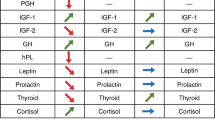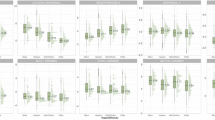Abstract
Background
In neonates, endocrine-sensitive physical endpoints, including breast and reproductive tissues, may reflect effects of fetal environmental exposure. Studies using standardized measurement techniques that describe demographic and clinical variability in these endpoints are lacking.
Methods
Three hundred and eighty-eight healthy term newborns <3 days old were evaluated, 69% African American and 25% White. Measures included breast bud diameter, anogenital distance (AGD), stretched penile length (SPL), and testicular volume (TV).
Results
Breast buds were larger in females than males bilaterally (right: 13.0 ± 4.0 vs. 12.0 ± 4.0 mm, p = 0.008; left: 13.0 ± 4.0 vs. 11.0 ± 3.0 mm, p < 0.001). Breast bud size correlated positively with gestational age (regression coefficient = 0.46 ± 0.12 mm, p < 0.001) and weight Z-score (0.59 ± 0.24 mm, p = 0.02), and negatively with White race (−1.00 ± 0.30 mm, p = 0.001). AGD was longer in males (scrotum-to-anus) than females (fourchette-to-anus) (21.0 ± 4.0 vs. 13.0 ± 2.0 mm, p < 0.001) and did not differ by race. SPL was shorter in White infants (35.0 ± 5.0 vs. 36.0 ± 5.0 mm, p = 0.04). Median TV was 0.5 cm3, and larger in White males (odds ratio 1.71, 95% confidence interval: 1.02–2.88)
Conclusions
This study provides a range of physical measurements of endocrine-sensitive tissues in healthy infants from the United States, and the associations with demographic and clinical characteristics.
Impact
-
This study reports physical measurements for endocrine-sensitive endpoints in healthy US newborns, including breast buds, AGD, SPL, and TV.
-
Associations of measurements to demographic and clinical factors (including race, gestational age, and newborn length and weight) are presented.
-
Contemporary ranges and identification of predictive factors will support further study on effects of pre- and postnatal exposures to endocrine-sensitive tissues in the infant.
Similar content being viewed by others
Log in or create a free account to read this content
Gain free access to this article, as well as selected content from this journal and more on nature.com
or
References
Swan, S. H. et al. Decrease in anogenital distance among male infants with prenatal phthalate exposure. Environ. Health Perspect. 113, 1056–1061 (2005).
Adgent, M. A. et al. A longitudinal study of estrogen-responsive tissues and hormone concentrations in infants fed soy formula. J. Clin. Endocrinol. Metab. 103, 1899–1909 (2018).
Mammadov, E., Uncu, M. & Dalkan, C. High prenatal exposure to bisphenol a reduces anogenital distance in healthy male newborns. J. Clin. Res. Pediatr. Endocrinol. 10, 25–29 (2018).
Arbuckle, T. E. et al. Meeting report: measuring endocrine-sensitive endpoints within the first years of life. Environ. Health Perspect. 116, 948–951 (2008).
Robinson, G. W., Karpf, A. B. & Kratochwil, K. Regulation of mammary gland development by tissue interaction. J. Mammary Gland Biol. Neoplasia 4, 9–19 (1999).
Wang, W., Tanaka, Y., Han, Z. & Higuchi, C. M. Proliferative response of mammary glandular tissue to formononetin. Nutr. Cancer 23, 131–140 (1995).
Zung, A., Glaser, T., Kerem, Z. & Zadik, Z. Breast development in the first 2 years of life: an association with soy-based infant formulas. J. Pediatr. Gastroenterol. Nutr. 46, 191–195 (2008).
Hotchkiss, A. K. et al. Prenatal testosterone exposure permanently masculinizes anogenital distance, nipple development, and reproductive tract morphology in female Sprague–Dawley rats. Toxicol. Sci. 96, 335–345 (2007).
Zarean, M., Keikha, M., Feizi, A., Kazemitabaee, M. & Kelishadi, R. The role of exposure to phthalates in variations of anogenital distance: a systematic review and meta-analysis. Environ. Pollut. 247, 172–179 (2019).
Arbuckle, T. E. et al. Prenatal exposure to phthalates and phenols and infant endocrine-sensitive outcomes: the MIREC study. Environ. Int. 120, 572–583 (2018).
Wenzel, A. G. et al. Influence of race on prenatal phthalate exposure and anogenital measurements among boys and girls. Environ. Int. 110, 61–70 (2018).
Clark, R. L. et al. Critical developmental periods for effects on male rat genitalia induced by finasteride, a 5 alpha-reductase inhibitor. Toxicol. Appl. Pharmacol. 119, 34–40 (1993).
Welsh, M., MacLeod, D. J., Walker, M., Smith, L. B. & Sharpe, R. M. Critical androgen-sensitive periods of rat penis and clitoris development. Int. J. Androl. 33, e144–e152 (2010).
Brandt, J. M., Allen, G. A., Haynes, J. L. & Butler, M. G. Normative standards and comparison of anthropometric data of White and Black newborn infants. Dysmorphol. Clin. Genet. 4, 121–137 (1990).
Cheng, P. K. & Chanoine, J. P. Should the definition of micropenis vary according to ethnicity? Horm. Res. 55, 278–281 (2001).
Feldman, K. W. & Smith, D. W. Fetal phallic growth and penile standards for newborn male infants. J. Pediatr. 86, 395–398 (1975).
Fok, T. F. et al. Normative data of penile length for term Chinese newborns. Biol. Neonate 87, 242–245 (2005).
Jain, V. G. et al. Anogenital distance is determined during early gestation in humans. Hum. Reprod. 33, 1619–27. (2018).
Cassorla, F. G. et al. Testicular volume during early infancy. J. Pediatr. 99, 742–743 (1981).
Kaplan, S. L. et al. Size of testes, ovaries, uterus and breast buds by ultrasound in healthy full-term neonates ages 0–3 days. Pediatr. Radiol. 46, 1837–1847 (2016).
Thankamony, A., Ong, K. K., Dunger, D. B., Acerini, C. L. & Hughes, I. A. Anogenital distance from birth to 2 years: a population study. Environ. Health Perspect. 117, 1786–1790 (2009).
Salazar-Martinez, E., Romano-Riquer, P., Yanez-Marquez, E., Longnecker, M. P. & Hernandez-Avila, M. Anogenital distance in human male and female newborns: a descriptive, cross-sectional study. Environ. Health 3, 8 (2004).
Shonfeld, W. A. Primary and secondary sexual characteristics: study of their development in males from birth to maturity, with biometric study of penis and testis. Am. J. Dis. Child. 65, 535–549 (1943).
Prader, A. Testicular size: assessment and clinical importance. Triangle 7, 240–243 (1966).
Barrett, E. S., Parlett, L. E., Redmon, J. B. & Swan, S. H. Evidence for sexually dimorphic associations between maternal characteristics and anogenital distance, a marker of reproductive development. Am. J. Epidemiol. 179, 57–66 (2014).
Romano-Riquer, S. P., Hernandez-Avila, M., Gladen, B. C., Cupul-Uicab, L. A. & Longnecker, M. P. Reliability and determinants of anogenital distance and penis dimensions in male newborns from Chiapas, Mexico. Paediatr. Perinat. Epidemiol. 21, 219–228 (2007).
McKiernan, J. F. & Hull, D. Breast development in the newborn. Arch. Dis. Child. 56, 525–529 (1981).
Francis, G. L., Hoffman, W. H., Gala, R. R., McPherson, J. C. 3rd & Zadinsky, J. A relationship between neonatal breast size and cord blood testosterone level. Ann. Clin. Lab. Sci. 20, 239–244 (1990).
Barry, J. A., Hardiman, P. J., Siddiqui, M. R. & Thomas, M. Meta-analysis of sex difference in testosterone levels in umbilical cord blood. J. Obstet. Gynaecol. 31, 697–702 (2011).
Ballard, J. L. et al. New Ballard Score, expanded to include extremely premature infants. J. Pediatr. 119, 417–423 (1991).
Sathyanarayana, S., Beard, L., Zhou, C. & Grady, R. Measurement and correlates of ano-genital distance in healthy, newborn infants. Int. J. Androl. 33, 317–323 (2010).
Papadopoulou, E. et al. Anogenital distances in newborns and children from Spain and Greece: predictors, tracking and reliability. Paediatr. Perinat. Epidemiol. 27, 89–99 (2013).
Jarrett, O. O., Ayoola, O. O., Jonsson, B., Albertsson-Wikland, K. & Ritzen, E. M. Penile size in healthy Nigerian newborns: country-based reference values and international comparisons. Acta Paediatr. 103, 442–446 (2014).
Kutlu, A. O. Normative data for penile length in Turkish newborns. J. Clin. Res Pediatr. Endocrinol. 2, 107–110 (2010).
Semiz, S., Kucuktasci, K., Zencir, M. & Sevinc, O. One-year follow-up of penis and testis sizes of healthy Turkish male newborns. Turk. J. Pediatr. 53, 661–665 (2011).
Rivkees, S. A., Hall, D. A., Boepple, P. A. & Crawford, J. D. Accuracy and reproducibility of clinical measures of testicular volume. J. Pediatr. 110, 914–917 (1987).
WHO. WHO Child Growth Standards (WHO, 2009).
Morisaki, N., Esplin, M. S., Varner, M. W., Henry, E. & Oken, E. Declines in birth weight and fetal growth independent of gestational length. Obstet. Gynecol. 121, 51–58 (2013).
Donahue, S. M., Kleinman, K. P., Gillman, M. W. & Oken, E. Trends in birth weight and gestational length among singleton term births in the United States: 1990–2005. Obstet. Gynecol. 115(Part 1), 357–364 (2010).
Acknowledgements
We are grateful to all subjects and families for their participation. We thank the care providers and staff at the University of Pennsylvania Hospital, Pennsylvania Hospital, Virtua Voorhees Hospital, Virtua Memorial Hospital, Abington Memorial Hospital, Cooper Memorial Hospital, and Holy Redeemer Hospital where these birth visits took place. We thank Els Nijs, M.D., Adeka McIntosh, M.D., Laura Poznick, R.D.M.S., Trudy Morgan, R.D.M.S., Marcy Hutchinson, R.D.M.S., R.V.T., Danielle Drigo, and the IFED Team of research assistants for their contributions. We also thank Walter J. Rogan M.D., Ph.D. for his many contributions to the IFED study. This research was supported in part by the Intramural Research Program of the NIH, National Institute of Environmental Health Sciences (Project Number Z01-ES044006). It was also supported by NIH/NIEHS (Protocol No. 10-E-N081), and the Nutrition Center at the Children’s Hospital of Philadelphia. The project described was supported by the National Center for Research Resources, Grant UL1RR024134, and is now the National Center for Advancing Translational Sciences, Grant UL1TR000003. This content is solely the responsibility of the authors and does not necessarily represent the official views of the NIH.
Author information
Authors and Affiliations
Contributions
Substantial contributions to conception and design, acquisition of data, or analysis and interpretation of data (J.I.S., B.A., A.K., E.F., B.S.Z., D.M.U., M.A., V.A.S.); drafting the article or revising it critically for important intellectual content (R.S., B.A., V.A.S.) and final approval of the version to be published (R.S., B.A., J.I.S., A.K., E.F., B.S.Z., D.M.U., M.A., V.A.S.).
Corresponding author
Ethics declarations
Competing interests
The authors declare no competing interests.
Patient consent
All subjects underwent consent process as approved by IRB, and signed written consents were collected.
Additional information
Publisher’s note Springer Nature remains neutral with regard to jurisdictional claims in published maps and institutional affiliations.
Rights and permissions
About this article
Cite this article
Shah, R., Alshaikh, B., Schall, J.I. et al. Endocrine-sensitive physical endpoints in newborns: ranges and predictors. Pediatr Res 89, 660–666 (2021). https://doi.org/10.1038/s41390-020-0950-2
Received:
Revised:
Accepted:
Published:
Issue date:
DOI: https://doi.org/10.1038/s41390-020-0950-2
This article is cited by
-
Sex-specific ranges and ratios for anogenital distance among Thai full-term newborns
BMC Pediatrics (2022)



